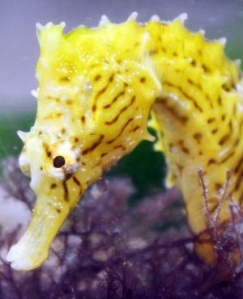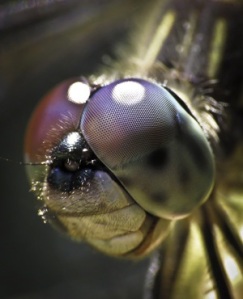Why the seahorse wins by a head
Close examination of the seahorse has shown that the cute little fish is a master of stealth, using streamlined features in its head to sneak up on its prey, scientists reported on Tuesday.
At first glance, the seahorse is an unlikely candidate for hunter of the year.
Swimming vertically, its tail curled, it progresses through coral reefs and shallow beds of seagrass thanks to a little dorsal fin that flutters three dozen times per second.
Its top speed is no more than 150cm an hour, a pace politely described as dignified.
By this yardstick, the species should not give planktonic copepods any sleepless nights. These are tiny crustaceans that are super-attuned to any water movement caused by an advancing predator.
The critters can move at super-speed, reacting to a peril within as little as two thousandths of a second.
They can propel themselves away at the speed of than 500 body lengths per second – the rough equivalent of a human clearing 10 football fields in a single leap.
Given these challenges, how is the ponderous seahorse able to eat?
The answer, according to a study published in the journal Nature Communications, lies in the extraordinarily hydrodynamic – the watery equivalent of aerodynamic – shape of its head.
With a long snout and sleek cheekbones, the organ offers minimal resistance to water, which enables the seahorse to ever-so-slowly sidle up on a copepod without being detected.
Once it gets within about 1mm of its target, the seahorse strikes, using a system of elastic-like tendons in its neck to drive its head forward, covering the distance in less than one thousandth of a second.
Laboratory tests using 3D holographic video found that dwarf seahorses (Hippocampus zosterae) were 84% successful at getting within range of a copepod without triggering an escape response.
Once they were in the 1mm strike zone, they were 94% successful in grabbing their prey.
The study, led by Brad Gemmell at the University of Texas at Austin, suggests that these insights could have applications in industry, when manufacturing processes need hydrodynamic microstructures that can be immersed into a fluid yet not disturb it.
Dragonfly inspires germ-slaying nanosurface
Imagine a hospital room, door handle or kitchen countertop that is free from bacteria – and not one drop of disinfectant or boiling water or dose of microwaves has been needed to zap the germs.
That is the idea behind a startling discovery made by scientists in Australia.
In a study published on Tuesday in the journal Nature Communications, they described how a dragonfly led them to a nano-tech surface that physically slays bacteria.
The germ-killer is black silicon, a substance discovered accidentally in the 1990s and now viewed as a promising semiconductor material for solar panels.
Under an electron microscope, its surface is a forest of spikes just 500 nanometres (500 billionths of a metre) high that rip open the cell walls of any bacterium which comes into contact, the scientists found.
It is the first time that any water-repellent surface has been found to have this physical quality as bactericide.
Sliced to shreds
Last year, the team, led by Elena Ivanova at Swinburne University of Technology in Melbourne, were stunned to find cicada wings were potent killers of Pseudomonas aeruginsoa – an opportunist germ that also infects humans and is becoming resistant to antibiotics.
Looking closely, they found that the answer lay not in any biochemical on the wing, but in regularly-spaced “nanopillars” on which bacteria were sliced to shreds as they settled on the surface.
They took the discovery further by examining nanostructures studding the translucent forewings of a red-bodied Australian dragonfly called the wandering percher (Latin name Diplacodes bipunctata).
It has spikes that are somewhat smaller than those on the black silicon – they are 240 nanometres high.
The dragonfly’s wings and black silicon were put through their paces in a lab, and both were ruthlessly bactericidal.
Smooth to the human touch, the surfaces destroyed two categories of bacteria, called Gram-negative and Gram-positive, as well as spores, the protective shell that coats certain times of dormant germs.
The three targeted bugs comprised P. aeruginosa, the notorious Staphylococcus aureus and the ultra-tough spore of Bacillus subtilis, a wide-ranging soil germ that is a cousin of anthrax.
The killing rate was 450 000 bacterial cells per square centimetre per minute over the first three hours of exposure.
This is 810 times the minimum dose needed to infect a person with S. aureus, and a whopping 77 400 times that of P. aeruginosa.
If the cost of making black silicon is an obstacle, many other options are around for making nano-scale germ-killing surfaces, said the scientists.
“Synthetic antibacterial nano-materials that exhibit a similar effectiveness… can be readily fabricated over large areas,” they wrote.


